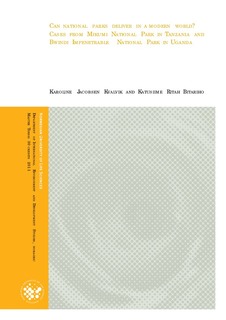| dc.description.abstract | Tanzania and Uganda are two countries in Africa with an outstanding abundance of
biodiversity. This biodiversity is usually conserved in Protected Areas such as national parks.
Mikumi National Park (MINAPA) and Bwindi Impenetrable National Park (BINP) are of
great international importance because of their ecological qualities. MINAPA and Selous
Game Reserve form a unique eco-system and together, they hold one of the largest
populations of wild elephants. BINP has exceptional biodiversity but its international
conservation value mostly emanates from being home to the endangered mountain gorillas.
The park as an organisation has increasingly become responsible for delivering biodiversity
conservation, tourist products and economic development, and also contributes to poverty
alleviation around the park. This study looks at, if the park as an organisation and institution is
equipped to deliver in all these areas. We have analysed MINAPA and BINP and also looked
at how practical cases of major problems faced by the two parks are handled by the
management. The parks are semi-autonomous, but still they have quite strict chains of
command throughout their management system. They are guided by formal rules and
procedures according to management plans such as the General Management Plan. The
division of labour is composed of diverse expertise and the parks‟ physical structures are
mostly underdeveloped and underfunded. This leads to both parks delivering more in areas of
biodiversity conservation and control of poaching, than in tourism and community
conservation. Furthermore, policies for these areas are present in the parks, but their
implementation is ineffective, leading to institutional failure.
Both national parks are surrounded by human settlements, whose integration in management
has had both positive and negative consequences. During our fieldwork, we discovered that
MINAPA and BINP employees hold strong conservation values and follow strict norms
relating to conservation. In addition to biodiversity conservation, TANAPA and UWA have
improved and increased community conservation and participation as one of their main
values. However, employees in the parks do not share the latter core value with their park
authorities. Further, our results also indicate that local people‟s values are linked to the
utilisation of park resources, which conflict with park management and its internal
stakeholders‟ values. This creates major challenges for both parties.
Local people surrounding MINAPA and BINP express that park authorities do not carry out
enough actions to address their concerns, whereas park staff claim that they are incapable of
responding to all local people‟s demands. Furthermore, local people are to a certain extent
involved in some of the parks‟ management programmes, particularly, revenue sharing,
problem animal and poaching control measures and multiple resource use, but park authorities
still dominate and control decision-making. The local people‟s attitudes have possibilities of
changing if they are involved more in park management and if issues such as problem
animals, poaching and their gains from the parks are addressed. As a result, aspects of
empowerment, responsibility and rights sharing could be improved. There is a need for an
organisational and institutional change of the park as an instrument in the direction of
improving the collaborative resource use management, particularly including local people
more in decision-making. | no_NO |
